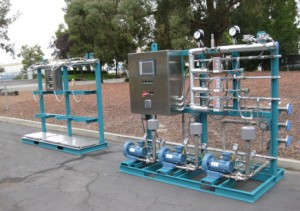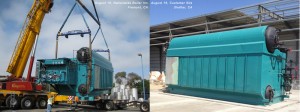1 Operate Boilers At or Close to Design Capacity. This decreases fuel consumption per unit of production and can result in an estimated energy savings range of 1 percent to 5 percent. Likewise, if your facility or plant requires excess capacity, visit the Nationwide Boiler website to obtain a current list of boilers for rent or for sale. Nationwide Boiler provides new and used boilers that can ship immediately, anywhere around the world (conditions apply, contact Nationwide Boiler for details).
2 Reduce Combustion Excess Air. Measure and control air-fuel ratio or oxygen and carbon monoxide content of flue gases from process heating equipment such as furnaces, ovens, and boilers for the entire range of operation. This has an estimated energy savings range of 2 percent to 15 percent. Think about installing a standard low NOx / low excess air burner (compared to an ULN / high excess air burner) on your boiler. Complemented with a Nationwide CataStak™ Selective Catalytic Reduction System (SCR), a new burner retrofit and SCR installation will not only provide immediate energy savings, but will also reduce NOx emissions and decrease your carbon footprint.
3 Clean Heat Transfer Surfaces. Cleaning heat transfer surfaces lowers flue gas temperature and increases efficiency by improving heat transfer. Doing so can save an estimated 1 percent to 5 percent at a moderate cost.
4 Reduce Radiation Losses from Openings. Reducing radiation losses can save an estimated 1 percent to 2.5 percent at a relatively low cost.
5 Use Proper Oven, Furnace or Boiler Insulation to Reduce Wall Heat Losses. Reducing wall losses produces energy savings of 1 percent to 2 percent with only a moderate investment.
6 Insulate Steam Lines Leaving the Boiler as well as Air- or Water-Cooled Surfaces Exposed to the Oven or Furnace Environment. With an estimated energy savings range of 1 percent to 5 percent, piping insulation can be completed for a moderate investment.
7 Install Air Preheaters or Other Heat Recovery Equipment. This type of equipment recovers available heat from exhaust gases and boiler blowdown and transfers it back into the system by preheating. The potential energy savings range id from 1 percent to 25 percent, depending on process temperatures and other variables. Consider a Nationwide Boiler EconoStak Economizer or a Heat Recovery (HR) Blowdown Pak to recover valuable heat that can be reused, allowing you to save money in the long-term.
Adapted from Process Heating Magazine, March 21, 2012.
Boiler Blog | Nationwide Boiler Inc.
We recently came across the following column written by Allan Bedwell, URS Corporation’s California Practice Leader for Climate Change & Renewable Energy Services. His article prepares food processors for the final implementation of AB 32, The Global Warming Solutions Act of 2006, aimed at reducing greenhouse gases.
AB 32 will certainly affect producers and processors, and, perhaps most importantly, will cause increases in the costs of energy inputs. As a result, costs relating to electricity, steam, fuel and water will be affected.
Don’t wait until it’s too late! Start preparing for AB 32 now and establish an AB 32 strategy. If you don’t know where to start, here’s where you can start:
This summer the California Air Resources Board (CARB) makes a series of AB 32 compliance and carbon allowance allocation decisions for food processors that will lock in facility carbon emission reduction targets for the next eight years. Before CARB locks in your facility carbon allowance allocations and launches carbon auctions, food processors should evaluate your options and chart a course forward to minimize your cost of compliance.
If you are wondering if you should buy carbon allowances during CARB’s upcoming auctions, the short answer is: Look before you leap. Before your company decides to buy or sell carbon allowances or offsets, determine what your facility compliance obligations will be during the next eight years and establish an AB 32 compliance strategy to guide your actions.
There are some key actions that food processors should do now to determine your compliance obligations and establish an AB 32 strategy. Actions to take now include:
- Strategically evaluate the baseline emissions data you are supposed to supply CARB by July 1. The agency will consider baseline years prior than 2008 to 2010.
- Estimate your carbon allowance allocations to determine if you are above or below CARB’s expected 90 percent allowance allocation.
- Develop cost curves for AB 32 compliance. Cost curves identify least cost options for achieving compliance and will serve as a compass to guide your company’s decisions about the relative value of reducing emissions on site, purchasing carbon allowances or offsets, banking emissions, or taking a hybrid approach.
- Calculate the net life cycle costs under different regulatory, allowance and offset cost scenarios. Net life cycle costs will guide your company’s effective comparison of emission management options.
- Actively evaluate CARB’s "benchmarking" methodology for carbon allowance allocations to determine if it’s accurate for your operations and processes. Each percentage point of lost efficiency can cost some facilities millions of dollars over the next eight years. Now is the time to negotiate with CARB before your emissions baseline, benchmarks and allocations are locked in.
- Before a product benchmark is established for food processors, determine its potential financial impacts to your facilities compared to the current allocation method.
- Approach the full costs of cap-and-trade strategically. Your electricity, steam, fuel and water suppliers will be affected by AB 32, and your facility will likely see significant utility cost increases as a result. Price your suppliers' carbon liability and incorporate the "pass-through" costs into a net life cycle analysis of your options. It may have a significant bearing on the actions you take under different regulatory and carbon market scenarios.
Carefully evaluate the full range of life cycle costs and the relative values of on-site reduction compared to buying or selling allowances and offsets. A large part of your AB 32 cost will come from increased energy costs. Not only can process improvements reduce your emission costs, but they can also reduce your electricity and gas bills.
A successful AB 32 compliance strategy has the flexibility to manage changing regulatory, legal and market conditions. Evaluate all your options and timing before you buy or sell carbon allowances or offsets. Most importantly, use net life cycle costs to chart your strategy to maximize the effectiveness of your actions to save costs under AB 32.
Nationwide Boiler recently supplied a single ammonia flow control system, designed to supply three boilers as part of a low NOx CataStak SCR system. It features a Honeywell touch screen operator interface with a 10” VGA LCD color display and is constructed in accordance with NEMA 4X. A bottle rack, complete with digital scales, was also supplied and handles three standard 150# ammonia bottles.
The system is currently being installed and another successful start-up for Nationwide Boiler is predicted.
CataStak SCR Ammonia Flow Control Unit
California, if considered a country, is among the top 20 emitters of CO2 worldwide. Current legislation addressing GHG include California Assembly Bill 32 (AB32), aimed at reducing existing GHG emissions to 1990 levels by 2020, and the California Environmental Quality Act’s (CEQA) Climate Change Action Plan that incorporates Best Performance Standards (BPS) measures into the review process to assist new boiler permit applicants (natural gas-fired units). The policy relies on the use of BPS to assess GHG emissions on global climate change and standards are incorporated in the overall design and operation of the equipment, providing the most efficient performance measures with major reductions in GHG emissions.
Current BPS examples that provide maximum efficiency benefits include:
- ? 20ºF Approach Temperature on the Economizer
- ? 15% Excess Air with O2 Trim
- ? 10% FGR
- VFD on Fan
- Heat Recovery on Blowdown if over 8%
Nationwide Boiler recently provided a BPS boiler solution to a CA pulp and paper customer governed by the San Joaquin Valley Air Pollution Control District (SVAPCD). BPS equipment included a 75,000 pph boiler, CataStak™ SCR system, EconoStak economizer and auxiliary equipment. The system incorporates the latest boiler upgrades and once in operation, will perform well below current NOX standards.
This system is one of many BPS solutions supplied by Nationwide Boiler, and BPS boilers in operation include several prominent food processors located throughout CA. Each company is committed to operate their boiler systems with the most technologically advanced equipment in the industry, doing their part in helping the environment and lowering overall GHG emissions, while running operations as efficiently as possible.
Nationwide Boiler BPS Boiler System Delivered
For additional information regarding BPS requirements, specific to the San Joaquin Valley, visit: http://www.valleyair.org/Programs/CCAP/bps/BPS_idx.htm#Boilers


